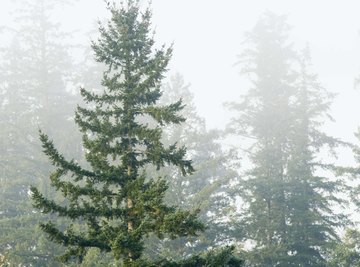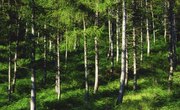
Coniferous trees feature two types of cones: the pollen cone and the seed cone. Some conifers have both cone types on the same tree, making it possible for the tree to pollinate itself. Cross pollination occurs when one tree produces only seed cones and therefore must be fertilized by pollen drifting to the seed cones from pollen cones located on other nearby trees.
Pollen Cones
Pollen cones are characteristically smaller and wider than seed cones. Pollen cones tend to whither and die once the pollen within the cones has been released to fertilize the seed cones. In its dormant phase, a conifer bud may be male, female or vegetative. Distinguishing among bud types at this stage is possible only by dissection. One clue that can help with pollen cone identification is its location. Seed cones tend to develop higher up in the tree to aid in dispersal once the seeds are pollinated.
Seed Cones
Seed cones are commonly used to identify tree type because they remain on or beneath the tree for a longer period of time. The slender seed cone buds swells for four to six weeks until the red or green-tipped ovuliferous scales begin to emerge. The scales tend to fold upright from the cone base and then droop downwards after accepting the pollen from the pollen cones to initiate seed development and signal cone maturity.
Arils
Some conifers have neither pollen nor seed cones. Instead, the tree produces fruit that partially covers the seeds. The Canadian yew is an example of an aril-producing conifer that contains a fleshy covering to contain the tree's seeds. In order to prevent excess seed loss due to animal and bird predators that may wish to feed on the fruit of the yew, this tree has adapted itself so that its fruit is toxic and the seeds are left undisturbed.
Scientific Classification and Seed Dispersal
Cone-bearing conifers, or pinophyta, are classified as gymnosperms (naked seeded) because their ovules and seeds are not enclosed within ovaries or found within protective fruit coverings. If a conifer has both pollen and seed cones on the same tree, it is further classified as a diploid sporophyte. Once the seeds are formed after pollination occurs, the scales of the cone open to release the seeds for dispersion by water, wind and the movement of man and animals.
References
About the Author
Kevin Ann Reinhart, a retired teacher-librarian, has written professionally since 1976. Reinhart first published in "Writers' Undercover" Cambridge Writers Collective II. She has a bachelor's degree in English and religious studies from the University of Waterloo and a librarian specialist certificate from Queen's University and the University of Toronto.
Photo Credits
Jupiterimages/Comstock/Getty Images
